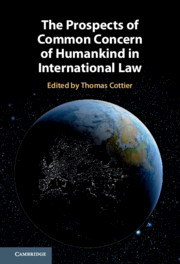Book contents
- The Prospects of Common Concern of Humankind in International Law
- The Prospects of Common Concern of Humankind in International Law
- Copyright page
- Contents
- Figures
- Contributors
- Preface
- Acknowledgements
- Abbreviations
- Part I Theory
- 1 The Principle of Common Concern of Humankind
- Part II Case Studies
- Part III Epilogue
- Index
- References
1 - The Principle of Common Concern of Humankind
from Part I - Theory
Published online by Cambridge University Press: 04 May 2021
- The Prospects of Common Concern of Humankind in International Law
- The Prospects of Common Concern of Humankind in International Law
- Copyright page
- Contents
- Figures
- Contributors
- Preface
- Acknowledgements
- Abbreviations
- Part I Theory
- 1 The Principle of Common Concern of Humankind
- Part II Case Studies
- Part III Epilogue
- Index
- References
Summary
Tracing the background and origins of common concern of humankind, this chapter elaborates the legal framework and normative components of a future principle of Common Concern of Humankind. While its contours have remained vague and undetermined so far, we suggest that a future principle could emerge in a process of claims and responses, consisting of essentially three dimensions. Problems actually or potentially posing a threat to international peace and stability - and thus in need to be addressed - entail obligations to consult and cooperate, beyond current disciplines of general public international law. It entails obligations to implement international obligations and commitments, in addition to domestic law which in the field, may deploy extraterritorial effects in addressing the shared problem at hand. Finally, the principle obliges states to act and take countermeasures, subject to proportionality, in response to free-riding and evasive states. The principle of Common Concern is not limited to international law, but may also deploy comparable effects within states and federations in addressing pressing shared problems. It has the potential to become an important building block of transnational federalism and multi-level governance and to assist restructuring different areas of public international law seeking greater cooperation and commitments in addressing pressing and shared regulatory needs.
Keywords
- Type
- Chapter
- Information
- Publisher: Cambridge University PressPrint publication year: 2021



